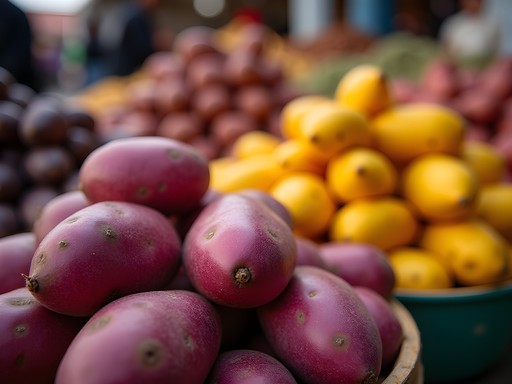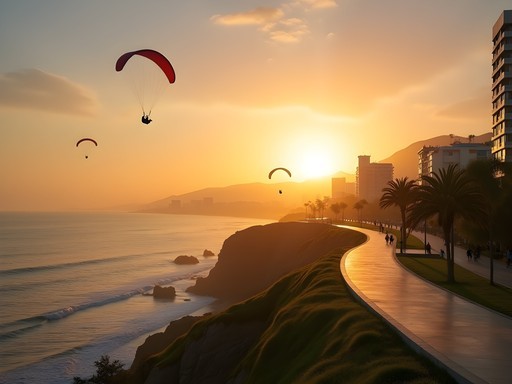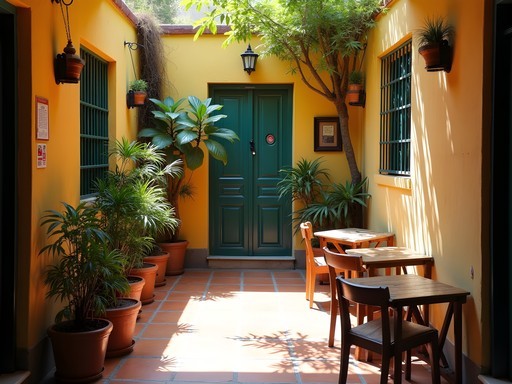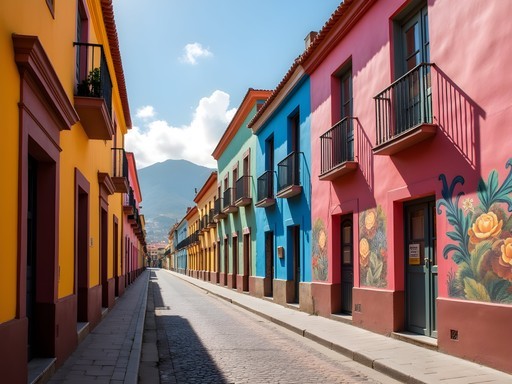Disclosure: This article contains affiliate links. We may earn a commission from purchases at no extra cost to you, which helps our travel content.
Standing in the misty morning light of Lima's Surquillo Market, I found myself experiencing what the Japanese call shime-tsuki - that perfect feeling of being exactly where you're meant to be. The vibrant colors of native potatoes in purple, yellow, and red hues; the symphony of voices haggling over fresh catch; the intoxicating aromas of unfamiliar spices. This wasn't just a market—it was the beating heart of a culinary revolution that has transformed Lima into South America's gastronomic capital.
The Soul of Lima: Market Explorations
Every meaningful food journey begins at the source, and in Lima, that means the markets. While tourists flock to Mercado Central, I found Surquillo Market to be where locals actually shop, making it my first stop each morning of my week-long stay.
Here, I discovered the building blocks of Peruvian cuisine—dozens of native potato varieties, corn kernels the size of quarters, and fruits I'd never seen before. The lúcuma particularly captivated me with its maple-like sweetness, while chirimoya (custard apple) quickly became my daily breakfast treat.
I documented everything through my camera lens, finding that early morning (around 7:00-8:00 AM) offered the best light for food photography. My travel tripod proved invaluable for capturing steady shots in the dim market lighting without disturbing vendors.
What struck me most was how this market experience mirrored memories of shopping with my mother in Yokohama's Motomachi shopping street—the same respect for ingredients, the careful selection process, the relationships between vendors and regulars that transcended mere transactions.

💡 Pro Tips
- Visit Surquillo Market between 7-10 AM for the freshest selection and best photography light
- Bring small bills (soles) for easier transactions with vendors
- Ask permission before photographing people, but most vendors are proud to show their products
Street Food: Lima's Culinary Democracy
There's something profoundly democratic about street food—it's cuisine without pretense, accessible to everyone. Lima's street food scene offers a crash course in Peruvian flavors that rivals any formal culinary education.
My favorite discovery was anticuchos—skewers of marinated beef heart grilled over open flames. At Doña Julia's stand in Barranco (a spot I found by simply following a line of locals), I watched as she fanned her coals with the precision of a sushi master, achieving that perfect char while keeping the meat tender. The marinade of ají panca, garlic, and vinegar created a depth of flavor that haunts me still.
For breakfast, picarones—sweet potato and squash doughnuts drizzled with molasses syrup—became my guilty pleasure, especially from a tiny cart near Kennedy Park. I'd sip my morning coffee from my insulated travel mug while watching the vendor skillfully form and fry these rings of deliciousness.
Perhaps most surprising was how ceviche exists in both high and low forms. The street version, served in plastic cups with sweet potato and giant corn kernels (choclo), offers the same bright flavors as restaurant versions at a fraction of the price. The best I found was near the fishing docks in Chorrillos, where the fish had been swimming just hours before.

💡 Pro Tips
- Look for street food stalls with lines of locals
- Eat ceviche before 3 PM when it's freshest
- Keep small change handy for quick transactions
The Middle Ground: Huariques and Cevicherías
Between street stalls and fine dining lies what might be Lima's most authentic culinary experience: the huarique. These small, family-run establishments serve home-style cooking with no frills but plenty of heart.
My favorite discovery was El Rincón Que No Conoces ("The Corner You Don't Know") in Lince district, where chef Teresa Izquierdo earned the title "Mother of Peruvian Cuisine" through her preservation of traditional recipes. Her carapulcra—a stew of dried potatoes with pork—exemplifies how humble ingredients transform through patient cooking into something extraordinary.
For ceviche, I became a regular at El Pescador in Miraflores, arriving promptly at noon when they open (and carrying my portable water filter to stay hydrated while waiting in the inevitable line). The cevicherías operate on a different schedule than other restaurants, typically opening around noon and closing by 4 PM when the day's catch is gone.
What fascinates me about these mid-range establishments is how they maintain tradition while subtly innovating. At La Picantería in Surquillo, I watched chef Héctor Solís prepare fish using techniques passed down for generations, yet with his own contemporary sensibility that keeps the cuisine evolving rather than fossilizing as mere heritage food.

💡 Pro Tips
- Most cevicherías are only open from roughly noon to 4 PM
- Arrive early or expect to wait, especially on weekends
- Order family-style to try more dishes, Peruvian portions are generous
Elevated Experiences: Lima's Gastronomic Revolution
Lima's rise to global culinary prominence didn't happen by accident. It was orchestrated largely by a generation of chefs who studied abroad, then returned home determined to elevate Peruvian ingredients to fine dining status. The results have been nothing short of revolutionary.
Central, Virgilio Martínez's temple to Peruvian biodiversity, was my splurge meal of the trip. His tasting menu—organized by elevation, from below sea level to high Andes—tells the story of Peru's remarkable ecological diversity through exquisitely presented bites. I documented each course with my mirrorless camera, though no photograph could fully capture the experience of tasting a potato grown at 15,000 feet elevation.
At Maido, chef Mitsuharu 'Micha' Tsumura's Nikkei cuisine resonated deeply with my Japanese heritage. Watching him blend Japanese techniques with Peruvian ingredients felt like witnessing my own cultural duality expressed through food. His nigiri made with local fish and ají-infused rice brought tears to my eyes—it was the taste of belonging, of cultures meeting without either being diminished.
What impressed me most about Lima's fine dining scene wasn't just the technical excellence, but the philosophy behind it. These restaurants don't exist in isolation; they've created an ecosystem that supports small producers, preserves biodiversity, and celebrates indigenous ingredients once dismissed as 'peasant food.' It's gastronomy with purpose, not merely for pleasure.


💡 Pro Tips
- Book Central and Maido at least 3 months in advance
- Consider lunch instead of dinner for better availability and lower prices at top restaurants
- Ask about the stories behind unusual ingredients—chefs are passionate about educating diners
Capturing Lima's Flavors: A Photographer's Guide
Food photography in Lima presents unique challenges and opportunities. The dramatic contrasts between rustic street food and architectural plating of fine dining establishments required me to constantly adjust my approach.
For market and street food photography, I found early morning light to be magical—soft, directional, and perfect for capturing the vibrant colors of ingredients. I relied heavily on my prime lens which handles low light beautifully without requiring flash (which would disturb the natural market atmosphere).
In cevicherías, where the preparation is often as beautiful as the finished dish, I positioned myself to capture both the hands at work and the ingredients being transformed. This storytelling approach connects viewers to the process, not just the result.
For fine dining experiences, I found it helpful to carry a small LED light that provides gentle fill light without disturbing other diners. Many high-end restaurants in Lima have dramatically dim lighting that, while atmospheric, can make food photography challenging.
Beyond technical considerations, I approached food photography in Lima as a form of mindfulness practice—being fully present with each dish, noticing textures, colors, and composition before even picking up my camera. This approach not only produced better images but deepened my appreciation of each culinary experience.

💡 Pro Tips
- Ask permission before photographing people preparing food
- Capture the context and environment, not just close-ups of dishes
- Learn basic Spanish phrases to communicate with vendors and chefs about their food
Final Thoughts
As my week in Lima drew to a close, I found myself sitting at a simple cevichería in Chorrillos, watching fishermen bring in their boats while savoring my final plate of sea bass bathed in tiger's milk. In that moment, I understood that Lima's culinary scene isn't just about world-class restaurants or street food discoveries—it's about a culture that has always understood food as a form of communication, of connection.
The Japanese concept of ichigo ichie teaches us to treasure each moment as unique and unrepeatable. Each meal in Lima embodied this philosophy—the particular fish caught that morning, the mood of the chef, the company shared across the table—all creating experiences that could never be precisely duplicated.
Whether you're a dedicated food photographer, a curious culinary explorer, or simply someone who appreciates a good meal, Lima offers a journey through flavors that will transform how you understand not just Peruvian cuisine, but food itself. Come hungry, bring an open mind, and prepare to fall in love one bite at a time.
✨ Key Takeaways
- Lima's food scene spans from humble street carts to world-class restaurants, with something for every budget
- Morning markets provide insight into the incredible biodiversity that forms the foundation of Peruvian cuisine
- Book fine dining restaurants months in advance, but don't miss the equally authentic experiences at local huariques
- The fusion of cultures—indigenous, European, African, Japanese, and Chinese—makes Peruvian cuisine uniquely diverse and innovative
📋 Practical Information
Best Time to Visit
year-round (Lima's food scene doesn't have a strong seasonal variation)
Budget Estimate
$50-100/day for food (excluding high-end restaurants)
Recommended Duration
5-7 days
Difficulty Level
Beginner
















Comments
Marco Flores
Your post captures Lima's culinary soul perfectly! I spent three weeks there last spring documenting the evolution from traditional to modern Peruvian cuisine. The contrast between the humble anticuchos vendors near Plaza de Armas and the molecular gastronomy at Central is what makes this city so special. My most memorable meal was actually at a tiny huarique in Chorrillos where an elderly woman served me the most transcendent causa I've ever tasted. She learned the recipe from her grandmother who sold food from a cart in the 1940s. These living connections to culinary history are what make Lima truly special. I used my food guide to find some hidden gems, but the best discoveries always came from talking with locals.
roamking
Marco, do you remember the name of that huarique in Chorrillos? I'll be in Lima next month!
Marco Flores
It's called 'Doña Paulina' - no sign, just look for a blue door near the fishing pier. Cash only and they close when they run out of food!
bluechamp
Heading to Lima in November for the first time. Any specific cevicherías you'd recommend that aren't too touristy?
Elizabeth Stephens
Try La Mar for an upscale experience, but my favorite was actually a tiny place called El Mordisco in Barranco. No English menu, plastic chairs, but the freshest fish you'll ever taste!
bluechamp
Thanks Elizabeth! Adding El Mordisco to my list right now.
citylife
Your description of that morning at Surquillo Market took me right back to my visit last year! The colors, the smells, the energy... Lima's food scene is incredible!
luckybuddy
Anyone know if it's safe to eat from the street vendors? I'm going in January and really want to try everything but worried about getting sick.
Frank Garcia
I ate street food daily and was fine. Look for busy stalls where locals eat. If they're cooking meat fresh in front of you and have a line of customers, it's usually safe. Bring hand sanitizer though!
Stephanie Romano
Elizabeth, your post captures Lima's food scene perfectly! On our family trip last year, we did something similar - starting with street food and working our way up to a special dinner at Maido (the kids were surprisingly adventurous!). The middle ground places were actually our favorites - especially La Picantería where they bring out the whole fish and prepare different parts in various ways. For anyone heading there, don't miss the sandwiches at La Lucha in Miraflores - my kids still talk about them. And the chocolate museum offers tastings that are perfect for families. The fruit markets were a highlight too - my daughter tried 12 fruits she'd never seen before! Beautiful writing that really captures the soul of Lima's food culture.
coffeephotographer7726
OMG THIS POST IS EVERYTHING!!! 😍😍😍 I'm heading to Lima next week and literally taking screenshots of all your recommendations! That market looks INCREDIBLE and I can't wait to try ALL THE CEVICHE! Did you have a favorite street food that I absolutely shouldn't miss? Also your photos are stunning - what camera do you use?
Elizabeth Stephens
Don't miss the anticuchos (beef heart skewers) - sounds intimidating but they're amazing! And thank you - just using my trusty Fuji X-T4 for these shots.
springbackpacker
Planning my first trip to Peru next year and food is my main priority! Is a week in Lima enough to experience all these different food scenes? Or should I split time between Lima and Cusco for food variety?
Stephanie Romano
A week in Lima is perfect for food exploration! Cusco has its own amazing dishes (try the alpaca and cuy if you're adventurous), but Lima is truly the culinary capital. I'd suggest 5 days Lima, 2-3 Cusco if you can. Make sure to book Central or Maido way in advance if you want the high-end experience!
springbackpacker
Thanks so much! Just booked my flights for March. I'll definitely try for Central reservations ASAP. Any recommendations for a good food tour on the first day to get oriented?
Stephanie Romano
The Lima Gourmet Company does an excellent evening tour that includes both local spots and higher-end places. Perfect introduction! I used my food guide to find some amazing off-the-beaten-path spots too.
hikingclimber
Just got back from Lima last month and the food scene blew me away! We did a cooking class in Barranco where we learned to make ceviche and pisco sours. The instructor took us to the local market first to pick ingredients. Totally different experience than just eating at restaurants. Elizabeth - your description of Surquillo Market brought me right back! Did you try any anticuchos from the street vendors? Those grilled beef hearts were surprisingly delicious!
Stephanie Romano
Those cooking classes are the best! Which one did you do? I'm heading to Lima with my kids in November and would love to find something family-friendly.
hikingclimber
We did the one at Sky Kitchen - super friendly and they were great with the family that brought kids. The rooftop views while cooking were amazing too!
Frank Garcia
Great post! One thing I learned backpacking through Peru last year is that timing is everything with Lima's food scene. Most cevicherías only serve until early afternoon because Peruvians believe fish should only be eaten fresh in the morning/early afternoon. Also, don't miss the picarones (sweet potato donuts) from street vendors - best late-night snack after bar hopping in Barranco. I found having a good food guide really helped me understand the regional ingredients and history behind the dishes. Elizabeth, did you notice how different the ceviche preparation is between the touristy spots and local joints?
Sarah Powell
Elizabeth, your piece perfectly captures Lima's culinary duality. I spent a month there researching for my own blog and found the contrast between street food and high gastronomy fascinating. What struck me most was how chefs like Gastón Acurio have elevated traditional ingredients while keeping them accessible. For anyone planning a visit, I'd recommend planning your fine dining reservations weeks in advance (Central and Maido book up quickly), but leave plenty of room for spontaneous market visits. The pre-dawn trip to Terminal Pesquero was worth the early wake-up call - watching the day's catch arrive gives you a new appreciation for your ceviche lunch. Did you make it to any of the northern Peruvian restaurants? Their seafood preparations are distinctly different from the Lima style.
luckybuddy
Sarah, any recommendations for mid-range places? Going next month and can't afford Central but want good authentic food!
Sarah Powell
Try El Mercado and Isolina in Barranco - fantastic food without the Michelin prices. Also, any cevichería that's packed with locals at lunch is a safe bet!
Venture X
Premium card with 2X miles, $300 travel credit, Priority Pass